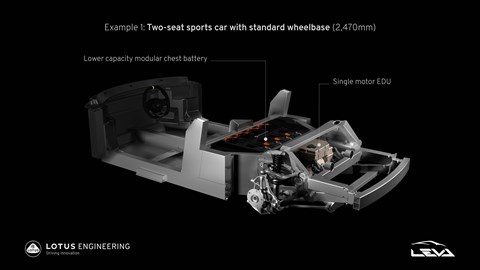► Lotus Type 135 electric sports car
► Here in 2027 to succeed Emira, Elise
► Built in Hethel, priced from £75k
The new Lotus Type 135 electric sports car will cost from £75,000, Hethel has confirmed in a briefing about future Lotus electric car plans – and CAR magazine’s new artist’s impression gives a flavour of what to expect from its upcoming new EV coupe.
Our rendering by ace computer illustrator Andrei Avarvarii is based on the shadowy teaser shot released earlier by Lotus (below, and in gallery above). It depicts a low-slung sports car with a lower stance than many EVs, thanks to some handy engineering innovations, and a family look evolved from the recent crop of two-doors and the halo-effect Lotus Evija supercar.
Lotus has revealed its ‘BEV sports car’ (denoting battery electric vehicle) will be shown in 2025, before customer deliveries start in 2027. It will replace the Emira, the final all-combustion Lotus sports car, according to senior executives and relaunch Lotus into its heartland sports car territory with annual sales of between 10,000-15,000 worldwide forecast (around double volumes of the Emira).
Lotus presentations reveal the $95,000 target price for the US market, equivalent to £75,000 at current exchange rates. It brings confirmation that hopes for an Elise-alike more affordable price positioning are dashed by the sheer cost of developing a new electric sports car platform.

The aluminium Elise was, somewhat incredibly, priced from just £18,995 at launch in 1995, ballooning to nearer £50k in its twilight years. The Lotus Elise ended production in February 2022 and the final edition was bought by its namesake, Elisa Artioli, the grand-daughter of former Lotus grandee Roman Artioli.
Lightweight Electric Vehicle Architecture (LEVA)
Lotus has already shown its new Lightweight Electric Vehicle Architecture (shortened to LEVA), a new platform that can be scaled to different needs in future. It is the secret sauce that allows a lower stance, often made impossible by the layout of skateboard chassis and battery packaging pains.
‘It is fully adaptable to provide a platform for a range of EVs with variable layouts, wheelbase lengths, battery sizes and configurations,’ the company revealed. ‘All three layouts feature a common lightweight die-cast rear sub-frame with multiple interchangeable components. This is the Project LEVA innovation, and it means a single vehicle architecture can accommodate two different types of battery configurations.’

For Type 135, Lotus is planning a classic ‘mid-engined’ layout, which swaps combustion engine for a chest of batteries stacked vertically behind the two seats. Entry models will come with a 66kWh battery, but that can be boosted to 99kWh for more premium models.
We expect the Type 135 to come with a single 350kW (469bhp) rear-mounted electric motor, although the LEVA platform can accommodate twin motors for a heady 650kW punch equivalent to 872bhp.
Lotus Type 135: Hethel’s electric sports car draws near
Lotus’s first electric car was the Evija hypercar – still the world’s most powerful production EV, according to the company. However, it is only just entering production now and just 130 derivatives will be sold for £1.7m apiece.
Lotus is now fleshing out the rest of its range with five core models (below), stretching from sports cars through SUVs and grand tourers. All the ‘lifestyle’ Lotus models will be manufactured in China, while the two sports cars will be made in England.

We have already seen the Lotus Eletre sports crossover on roads now while the Lotus Emeya GT was unveiled in 2023 and will arrive in showrooms in Europe in the second half of 2024.
An electric Elise?
Purists will, however, be waiting for the all-new electric sports car, codenamed Type 135 and due to be built in Norfolk at the company’s spiritual home. Mike Johnstone, chief commercial officer, told CAR that Lotus was developing a bespoke platform, after a collaboration with Alpine Cars was abandoned.
‘We’re going it alone,’ he said. ‘It’s our bullseye: a pure two-seater that must live and breathe the brand. Someone who’s owned an Elise or Esprit should be able to get into the Lotus Type 135 and feel instantly at home.’
Some may consider that to be a tall order; the lightest Series 1 Elise weighed as little as 690kg at launch, thanks to its clever extruded aluminium chassis technology – it’s hard to imagine the Type 135 won’t weigh at least double that, and very probably much more.
Regardless, the latter half of the decade should be interesting for electric sports cars; the Type 135 will be fighting for sales with the upcoming pure electric Porsche Boxster/Cayman successor, as well as Alpine EVs.